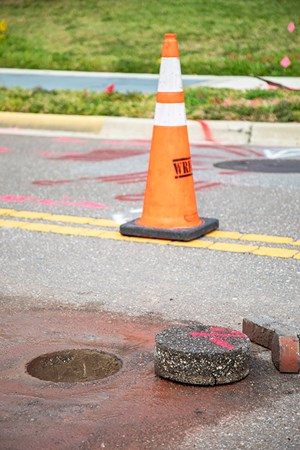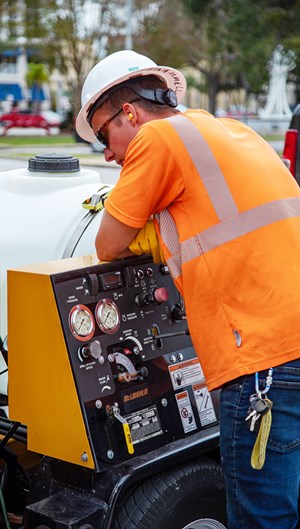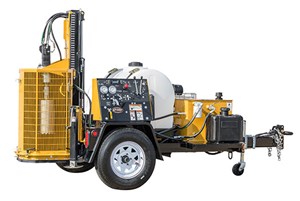August 2023 Vol. 78 No. 8
Features
Hard surface potholing the right way helps a business grow
McKim & Creed’s self-contained core saws minimize restoration work
More Florida cities are seeing the advantages of core saws, since McKim & Creed expanded into coring solid surfaces to locate utilities.
“Many city officials are talking to each other about the best way to perform these services without causing additional harm to the streets,” said Ryan King, project manager at McKim & Creed. “They don’t like to close sections of busy streets for days at a time and are concerned about what patch repairs may do to the long-term integrity of their streets.

“After seeing how much less invasive coring is, they started to require it on projects that involve locating and potholing utilities. And since we’ve earned a reputation for outstanding work with our Vermeer CS418B core saws, our team is usually the project owner’s first call.”
McKim & Creed is an engineering and surveying firm based in Raleigh, N.C. While the company offers a wide range of engineering services throughout the United States, its subsurface utility engineering (SUE) department is one of its fastest-growing areas.
“SUE information helps engineers during the planning process, supports a safe work environment and helps construction jobs stay on budget,” said King. “The work we do can range from surveying above ground and underground infrastructure to make sure it matches existing utility records, to using specialized digging equipment to confirm the precise horizontal and vertical position of utilities.”
King works out of McKim & Creed’s SUE location in Sarasota, Fla., and primarily provides locating services for utility companies. His team’s services expanded in recent years after several municipalities shared concerns about roadway, sidewalk and turf condition after contractors had finished verifying utilities.
“Overall, contractors are doing a good job of confirming locates by exposing existing utilities ahead of any excavating or horizontal directional drilling work,” said King. “However, contractors will often opt for potholing methods that can make it challenging to restore an area to its original conditions – especially when it comes to hard surfaces like roadways and sidewalks.”
Hard surface potholing challenges
Around three years ago, the team at McKim & Creed sat down with area utility companies and municipalities to discuss this ongoing challenge.
“Contractors performing the work were employing a variety of methods digging under streets and sidewalks but over time, the restoration work wasn’t holding up very well,” said King. “It was common for contractors to use cut-off saws and jackhammers to get through the hard surface and dig from there.
“Afterward, the soil was packed back in, and an asphalt or concrete patch was applied. But as the soil settled and patches weathered, streets and sidewalks were left with dips, humps and/or potholes. In many cases, cities have been forced to mill down roads and apply new asphalt to restore them properly.”
That wasn’t the only issue cutting and jackhammering through roadways can cause. Locating and daylighting existing utilities led to significant lane closures due to the amount of equipment required and the steps involved with the process. Crews often need to search for utilities, so they extend the holes and tear up more surface area than expected. This leads to larger sections of asphalt or concrete to repair.
“Hard surface potholing can be a huge challenge when a crew isn’t using the right tools for the job,” said King. “And unfortunately, many don’t take the time to learn about the industry’s best practices.”
Testing core saw options
After learning about the frustrations utility companies and municipalities were having, McKim & Creed set out to devise a better solution. The initial workaround was a mechanical core saw mounted to the front of a service van.
“The mechanical core saw was a good first step for us because it addressed our customers’ concerns about some of the issues involved with using cut-off saws and jackhammers,” he explained. “Once a core was drilled, we could vacuum excavate material underneath until we reached the underground line, fill the hole back in and epoxy the core back in place. The problem was that the setup wasn’t very efficient. We had to bring in extra equipment and run water lines. It was time-consuming.”
After a year of proving that coring was the right solution for hard surface potholing, the team set out to find a better core saw setup.
McKim & Creed’s search led them to the local Vermeer Southeast dealership, where the team got a chance to demo the Vermeer CS418B core saw. According to King, this unit had an immediate impact on productivity.
“It’s a self-contained, trailered core saw that doesn’t require extra equipment or setup time,” he said. “A gas engine powers the saw. It has a 100-gallon water system onboard, so we don’t have to bring in an extra tank and pump. And the whole thing is compact and lightweight. We can pull it to the job with our Chevy Colorado work trucks.”
Since purchasing its first CS418B core saw, McKim & Creed added two more at its Sarasota location and several other locations.
“Utility companies we contract for and the municipalities where the work is being done like the results we deliver with these core saws,” King explained. “On many projects, they no longer leave it up to the contractor to pothole utilities under hard surfaces. Instead, they are hiring us to do it ahead of time, so they know the restoration work will be done right and hold up as long as the rest of the road.”

Core sawing process
Most of the core saw work that McKim & Creed performs is related to road construction or utility expansion projects.
“For a long time, utility owners and municipalities didn’t document the location of everything buried underground,” said King. “They weren’t thinking about road expansion projects or other utility work that might happen 20 to 40 years later.
“Our team’s first attempt is to track down old records that may give us a clue about what might be underground. In many cases, we also have to bring in ground penetrating radar (GPR) to assist with that step. Once we have a general idea of where lines may be, we must verify it. That means seeing a utility with our eyes and marking GPS coordinates.”
McKim & Creed’s crews usually work in the evening when there is less traffic. Once traffic barriers are in place, three people get to work coring and potholing.
“The process starts with the core saw,” explained King. “We use a 12-inch core bit to cut a hole in the asphalt or concrete and then move the unit to the next location. Once that’s done, we use an air vacuum excavator to dig down to the utility and record its exact location. Then we refill the hole with the same material we excavated and compact it. We put down a layer of pea gravel near the surface, lay down some epoxy and replace the core.”
If the utility cannot be identified in the first hole, the McKim & Creed crew will drill multiple cores near each other, rather than chase the locate by opening up more of the hard surface, as some contractors do.
“Coring the street is faster than cutting or breaking up the surface and performing significant street repair. City officials and the DOT prefer this approach, too,” he added.
On average, with a team of three people, McKim & Creed will pull and replace between seven and eight cores in a shift. Most of the time, the team works overnight hours. By morning all lanes can be reopened.
“All restoration can be completed in a single shift, and within a few weeks, most people can’t even tell where the road was cored,” concluded King.
FOR MORE INFORMATION:
McKim & Creed, (919) 233-8091, mckimcreed.com/
Vermeer Corp., (888) 837-6337, vermeer.com
Vermeer Southeast, (888) 803-1870, vermeersoutheast.com/





Comments